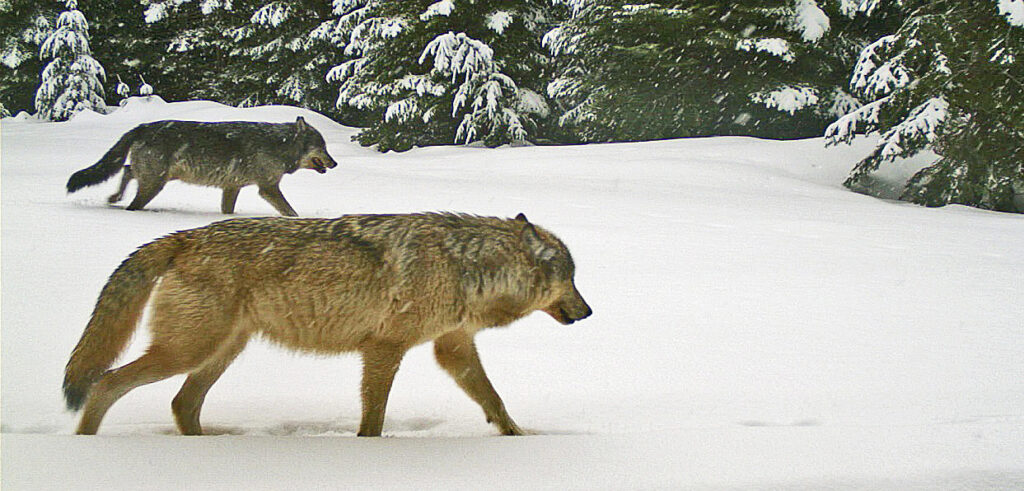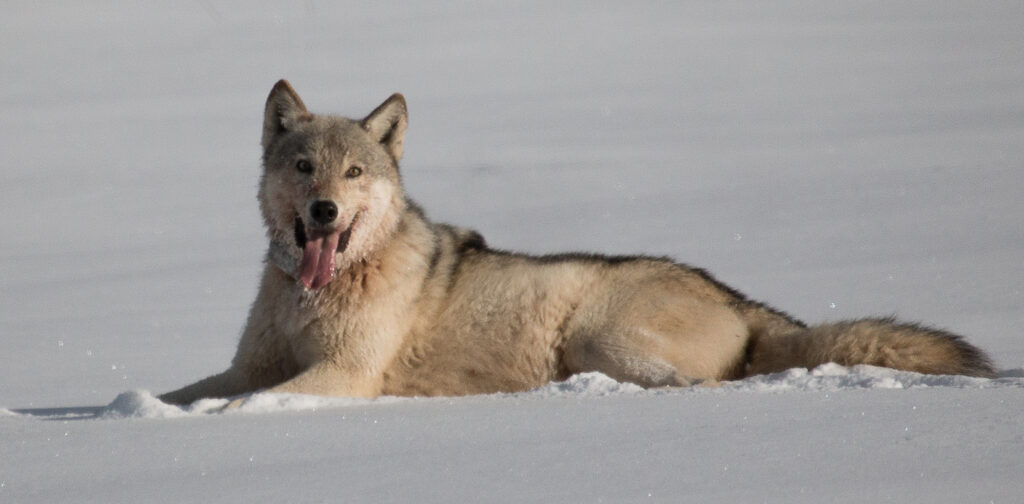
Why are wolves important to the Pacific West?
Wolves are native to the Pacific West states of Washington, Oregon and California and part of this region’s wildlife heritage. As a top predator, wolves naturally help keep wild elk, deer, and moose populations in balance with available habitat. Scientists in Yellowstone have documented that the return of the wolf has kept elk more alert and on the move, which has reduced overgrazing of streamside vegetation. This in turn has benefited a suite of animals from songbirds to beavers. Recovering this endangered species will help return an important missing element of the Pacific West’s complex of carnivores.
How many wolves are currently living in the Pacific West states?
As of 2023 minimum wolf counts, there are 260 wolves in Washington and 42 wolf families. In Oregon, there are 178 wolves and 22 wolf families. While wolf populations in Washington continue to grow, 2023 showed a plateau in wolf population growth in Oregon for the first time since their return to the state. California is home to at least 40 wolves and seven wolf families.
Were wolves reintroduced to the Pacific West?
No. Wolves returned naturally from dispersing populations in nearby states and provinces, like Idaho and British Columbia. The California Department of Fish and Wildlife, the Oregon Department of Fish and Wildlife, the Washington Department of Fish and Wildlife, and the U.S. Fish and Wildlife Service never reintroduced or transplanted wolves into the Pacific West.
How did wolves re-populate the West?
Between 1995-1996, the U.S Fish and Wildlife Service (USFWS) reintroduced 66 wolves from Canada into Wyoming and Idaho – 31 wolves into Yellowstone National Park and 35 into central Idaho. At that time, about 60 wolves were documented in the northwestern corner of Montana (see Map 1). Since then, wolf populations continued to recover throughout the Northern Rocky Mountains, but have been heavily persecuted by hunting and trapping after losing Endangered Species Act protections.
Why do wolves howl?
The howl of a wolf is one of its primary sources of communication and is used in a variety of situations, including gathering the pack, defense of territories, maintaining social bonds with other pack members, and attracting a mate. Wolves are highly social animals that utilize a complex system of non-verbal behaviors to regulate and maintain pack structure.
“I THINK I saw a wolf, but how do I know for sure?”
Wolves generally stay away from people, so seeing one is rare. However, their numbers are increasing in some regions and state wildlife departments appreciate hearing from members of the public about any sightings, tracks, or howling they observe. Wolves can be easily confused with other similar species, most readily coyotes. Check the descriptions below to figure out if you actually saw a wolf.
Coyotes are the species most commonly confused with wolves, so some of the best clues for identifying an animal are in the distributed by by USFWS. Coyotes are often seen because they are abundant throughout the Pacific West and can be somewhat bold.
One of the greatest differences between the two species is size, which can be difficult to estimate at a distance. A gray wolf is much larger than a coyote. Wolves weigh 80 to 120 pounds, while coyotes weigh 20 to 50 pounds. Track size measures about four by five inches for wolves, compared to two by two and a half inches for coyotes.
Ear shape is also much different; wolves have somewhat rounded ears while coyotes have taller, pointed ears. Wolves have a broader, shorter snout, while coyotes have a narrower, more pointed nose. A wolf’s howl is long and drawn out, while a coyote produces a shorter, yapping sound. Fur coloration can be quite similar between wolves and coyotes and therefore is not a good characteristic for separating the two species.
» Wolf Identification: Physical Appearance of Wolves.
Large dogs and wolf-dog hybrids can also be mistaken for wolves, although they usually act more familiar with people. Wolf-dog hybrids can be unpredictable and aggressive. Some hybrids have been released into the wild, living like feral dogs. Distinctions between these hybrids and wild wolves can sometimes be made only by DNA testing. If you do see an animal you suspect may be a wolf, take a picture if possible, note the exact location, date, number of animals and what the animals are doing, and please let your state Fish and Wildlife department know.

“I KNOW I saw a wolf, so where do I report it?”
All state agencies and the U.S. Fish & Wildlife Service keep track of wolf sightings and other evidence of wolves (tracks, scat, howling, and photos from motion-sensitive remote cameras).
- Washington: The best way to make a report is through WDFW’s Online Wolf Reporting Form or via the toll-free wildlife reporting hotline, 1-877-933-9847.
- Oregon: Make your report through ODFW’s reporting form or call your nearest field office.
- California: Contact the nearest CDFW Regional Office or the Headquarters Wildlife Branch.
Do wolves harm humans?
Gray wolves generally fear and avoid people, and rarely pose a threat to human safety. In the past 60 years, there have been two wolf-caused human fatalities in North America (Canada and Alaska).
Two broad summaries published in 2002 documented 28 reports of wolf aggression towards humans in North America from 1969 to 2001. Nineteen of these involved wolves habituated to people and five involved people accompanied by domestic dogs. There have been no physical attacks on people by wolves in Idaho, Montana, or Wyoming from the time wolf recovery began in the 1980s.
Wolves passing near, watching, or otherwise behaving in a non-threatening way near humans should not necessarily be considered dangerous. But wolves can become habituated to humans in areas where they regularly encounter humans or human food. To avoid habituation, wolves should never be fed or approached. If wolves seem too comfortable near people, or frequent roads or trails where close encounters are more likely, they should be hazed using non-lethal methods like air horns or other scare devices.
Do wolves affect game species?
Yes, wolves can affect the populations of game species as keystone species in ecosystems, however, they will not wipe them out. Elk populations in states such as Idaho and Montana with far more wolves than states in the Pacific West have remained relatively stable over the past decade. The average number of elk harvested by hunters in those states has also shown little change during that time.
Wolves are just one of many factors affecting elk and deer populations. Others include harsh weather, poor habitat, high hunter harvest rates, and other predators such as cougars and bears. While wolves may contribute to the decline of a weak herd, experience in other states indicates they are seldom the primary cause of that condition.
Read more on the website of Pacific Wolf Coalition member, Living with Wolves.
*Largely adapted from the Washington Department of Fish and Wildlife, Oregon Department of Fish and Wildlife, and California Department of Fish and Wildlife.
